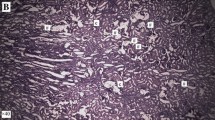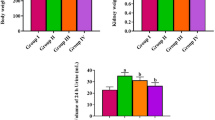Abstract
Urolithiasis is a common urological disorder, which causes considerable morbidity in both genders at all age groups worldwide. Though treatment options such as diuretics and non-invasive techniques to disintegrate the deposits are available, but often they are found less effective in the clinics. In this work, we planned to investigate the ameliorative effects of daidzin against the ethylene glycol (EG)-induced urolithiasis in rats. The male albino rats were distributed into four groups (n = 6) as control (group I), urolithiasis induced by the administration of 0.75% EG (group II), urolithiasis induced rats treated with 50 mg/kg of daidzin (group III), and urolithiasis rats treated with standard drug 750 mg/kg of cystone (group IV). The urine volume, pH, and total protein in the urine were assessed. The activities of marker enzymes in both plasma and kidney tissues were analyzed using assay kits. The levels of kidney function markers such as calcium, oxalate, urea, creatinine, uric acid, magnesium, BUN, and phosphorous were estimated using assay kits. The status of antioxidants and inflammatory cytokines were also examined using kits. The renal tissues were examined by histopathological analysis. Our results revealed that the daidzin treatment effectively decreased the urine pH and protein level and increased the urine volume in the urolithiasis rats. Daidzin decreased the calcium, oxalate, uric acid, and urea, creatinine, and BUN levels and also improved the magnesium and phosphorus in the urolithiasis rats. The activities of AST, ALT, ALP, GGT, and LDH were effectively reduced by the daidzin in both serum and renal tissue. Daidzin also reduced the inflammatory marker and increased the antioxidant levels. Histopathology results also proved the therapeutic effects of daidzin. Together, our results displayed that daidzin is effective in the amelioration of EG-induced urolithiasis in rats.







Similar content being viewed by others
Data Availability
Not applicable.
Abbreviations
- EG:
-
Ethylene glycol
- CKD:
-
Chronic kidney disease
- ESRD:
-
End-stage renal disease
- AST:
-
Aspartate transaminase
- ALT:
-
Alanine transaminase
- ALP:
-
Alkaline phosphatase
- GGT:
-
Gamma glutamyl transferase (GGT)
- LDH:
-
Lactate dehydrogenase
- KCl:
-
Potassium chloride (KCl)
References
Khan, S., et al. (2016). Kidney stones. Nature Reviews Disease Primers, 2(1), 1–23.
Robertson, W. G. (2003). Renal stones in the tropics. Seminars in Nephrology, 23(1), 77–87.
Wathigo, F. K., Hayombe, A., & Maina, D. (2017). Urolithiasis analysis in a multiethnic population at a tertiary hospital in Nairobi. Kenya. BMC Res Notes, 10, 158. https://doi.org/10.1186/s13104-017-2474-3
López, M., & Hoppe, B. (2010). History, epidemiology and regional diversities of urolithiasis. Pediatric Nephrology, 25(1), 49–59.
Strope, S. A., Stuart Wolf, J., & Hollenbeck, B. K. (2010). Changes in gender distribution of urinary stone disease. Urology, 75(3), 543-546.e1.
Shah, J., & Whitfield, H. (2002). Urolithiasis through the ages. BJU International, 89(8), 801–810.
Worcester, E., & Coe, F. (2008). Nephrolithiasis. Primary Care: Clinics in Office Practice, 35(2), 369–391.
Jawalekar, S., Surve, V., & Bhutey, A. (2010). The composition and quantitative analysis of urinary calculi in patients with renal calculi. Nepal Medical College Journal, 12(3), 145–148.
El-Zoghby, Z., et al. (2012). Urolithiasis and the risk of ESRD. Clinical Journal of the American Society of Nephrology, 7(9), 1409–1415.
Zisman, A. (2017). Effectiveness of treatment modalities on kidney stone recurrence. Clinical Journal of the American Society of Nephrology, 12(10), 1699–1708.
Dharmalingam, S., et al. (2014). Anti-urolithiatic activity of Melia azedarach Linn leaf extract in ethylene glycol-induced urolithiasis in male albino rats. Tropical Journal of Pharmaceutical Research, 13(3), 391–397.
Kant, R., Singh, T., & Singh, S. (2020). Mechanistic approach to herbal formulations used for urolithiasis treatment. Obesity Medicine, 19, 100266.
York, N., Borofsky, M., & Lingeman, J. (2015). Risks associated with drug treatments for kidney stones. Expert Opinion on Drug Safety, 14(12), 1865–1877.
Pareta, S., Patra, K., Mazumder, P., & Sasmal, D. (2011). Establishing the principle of herbal therapy for antiurolithiatic activity: A review. Journal of Pharmacology and Toxicology, 6(3), 321–332.
Erickson, S., Vrtiska, T., & Lieske, J. (2011). Effect of Cystone® on urinary composition and stone formation over a one year period. Phytomedicine, 18(10), 863–867.
Pongkitwitoon, B., Sakamoto, S., & Tanaka, H. (2009). Enzyme-linked immunosorbent assay for total isoflavonoids in Pueraria candollei using anti-puerarin and anti-daidzin polyclonal antibodies. Planta Medica, 76(8), 831–836.
Jin, W., Tan, Y., Chen, Y., & Wang, Y. (2003). Determination of puerarin, daidzin and daidzein in root of Pueraria lobata of different origin by HPLC. Zhongguo Zhong Yao Za Zhi (in Chinese), 28(1), 49–51.
Zhou, H., Wang, J., & Yan, F. (2007). Separation and determination of puerarin, daidzin and daidzein in stems and leaves of Pueraria thomsonii by RP-HPLC. Zhongguo Zhong Yao Za Zhi (in Chinese), 32(10), 937–939.
Park, E., et al. (2006). Intestinal bacteria activate estrogenic effect of main constituents puerarin and daidzin of Pueraria thunbergiana. Biological & Pharmaceutical Bulletin, 29(12), 2432–2435.
Osman, S., & Fett, W. (1983). Isoflavone glucoside stress metabolites of soybean leaves. Phytochemistry, 22(9), 1921–1923.
Rha, C., et al. (2019). Simple and efficient production of highly soluble daidzin glycosides by amylosucrase from Deinococcus geothermalis. Journal of Agricultural and Food Chemistry, 67(46), 12824–12831.
Keung, W., & Vallee, B. (1998). Daidzin and its antidipsotropic analogs inhibit serotonin and dopamine metabolism in isolated mitochondria. Proceedings of the National Academy of Sciences, 95(5), 2198–2203.
Yagasaki, K. (2019). Phytochemicals, their intestinal metabolites, and skeletal muscle function (pp. 421–438). Academic Press.
Yasuda, T., Kano, Y., Saito, K., & Iohsawa, K. (1994). Urinary and biliary metabolites of daidzin and daidzein in rats. Biological and Pharmaceutical Bulletin, 17(10), 1369–1374.
Cloutier, J., Villa, L., Traxer, O., & Daudon, M. (2015). Kidney stone analysis: “Give me your stone, I will tell you who you are! World Journal of Urology, 33(2), 157–169.
Alelign, T., & Petros, B. (2018). Kidney stone disease: An update on current concepts. Advances in Urology., 2018, 1–12.
Tasian, G., Kabarriti, A., Kalmus, A., & Furth, S. (2017). Kidney stone recurrence among children and adolescents. The Journal of Urology, 197(1), 246–252.
Orhan, N., Onaran, M., Sen, L., & Gonul, L. (2015). Preventive treatment of calcium oxalate crystal deposition with immortal flowers. Journal of Ethnopharmacology, 163, 60–67.
Karadi, R. V., Gadge, N. B., Alagawadi, K. R., & Savadi, R. V. (2006). Effect of Moringaoleifera Lam. root-wood on ethylene glycol induced urolithiasis in rats. Journal of Ethnopharmacology., 105, 306–311.
Selvam, R., Kalaiselvi, P., Govindaraj, A., BalaMurugan, V., & Sathish Kumar, A. S. (2001). Effect of A. lanata leaf extract and vediuppuchunnam on the urinary risk factors of calcium oxalate urolithiasis during experimental hyperoxaluria. Pharmacological Research, 43, 89–93.
Evan, A. P., Worcester, E. M., Coe, F. L., Williams, J., & Lingeman, J. E. (2015). Mechanisms of human kidney stone formation. Urolithiasis., 43(Suppl. 1), 19–32.
Huang, H. S., Ma, M. C., Chen, C. F., & Chen, J. (2003). Lipid peroxidation and its correlations with urinary levels of oxalate, citric acid, and osteopontin in patients with renal calcium oxalate stones. Urology, 62, 1123–1128.
Khan, S. R. (2013). Reactive oxygen species as the molecular modulators of calcium oxalate kidney stone formation: Evidence from clinical and experimental investigations. Journal of Urology, 189, 803–811.
Dwiecki, K., Neunert, G., Polewski, P., & Polewski, K. (2009). Antioxidant activity of daidzein, a natural antioxidant, and its spectroscopic properties in organic solvents and phosphatidylcholine liposomes. Journal of Photochemistry and Photobiology B: Biology, 96(3), 242–248.
Khan, S. R., Canales, B. K., & Dominguez-Gutierrez, P. R. (2021). Randall’s plaque and calcium oxalate stone formation: Role for immunity and inflammation. Nature Reviews. Nephrology, 17(6), 417–433.
Umekawa, T., Chegini, N., & Khan, S. R. (2002). Oxalate ions and calcium oxalate crystals stimulate MCP-1 expression by renal epithelial cells. Kidney International, 61, 105–112.
Aihara, K., Byer, K. J., & Khan, S. R. (2003). Calcium phosphate-induced renal epithelial injury and stone formation: Involvement of reactive oxygen species. Kidney International, 64, 1283–1291.
Wang, Z. V., & Scherer, P. E. (2016). Adiponectin, the past two decades. Journal of Molecular Cell Biology, 8, 93–100.
Hao, R., Su, G., Sun, X., et al. (2019). Adiponectin attenuates lipopolysaccharide-induced cell injury of H9c2 cells by regulating AMPK pathway. Acta Biochimica et Biophysica Sinica (Shanghai), 51, 168–177.
Author information
Authors and Affiliations
Contributions
The authors contributed equally.
Corresponding author
Ethics declarations
Ethics Approval
All work has been done under the guidelines of Institutional Ethics Committee.
Consent to Participate
All authors have their consent to participate.
Consent for Publication
All authors have their consent to publish their work.
Competing Interests
The authors declare no competing interests.
Additional information
Publisher's Note
Springer Nature remains neutral with regard to jurisdictional claims in published maps and institutional affiliations.
Rights and permissions
Springer Nature or its licensor holds exclusive rights to this article under a publishing agreement with the author(s) or other rightsholder(s); author self-archiving of the accepted manuscript version of this article is solely governed by the terms of such publishing agreement and applicable law.
About this article
Cite this article
Yuan, S., Ibrahim, I.A.A. & Ren, R. Anti-urolithiatic Activity of Daidzin in Ethylene Glycol-Induced Urolithiasis in Rats. Appl Biochem Biotechnol 195, 905–918 (2023). https://doi.org/10.1007/s12010-022-04124-y
Accepted:
Published:
Issue Date:
DOI: https://doi.org/10.1007/s12010-022-04124-y




